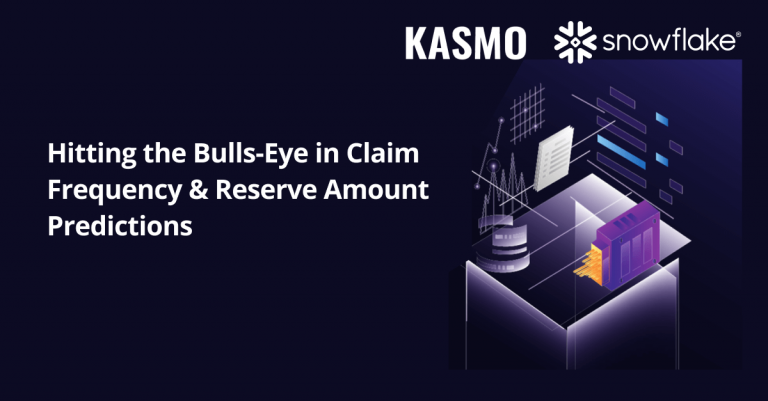Companies in the Insurance industry often face challenges in predicting claim frequency and reserve amounts. Accurate projections are important for risk management, premium rate establishment, and overall financial stability. Kasmo’s data engineering and ai services enable insurance companies to make informed decisions. Our approach involves conducting a thorough analysis of historical data to predict how often insurance claims might occur. This helps businesses prepare for risks ahead of time and plan finances accurately. Using Kasmo’s data analytics solutions gives companies in the insurance sector an edge, ensuring strong decision-making in a constantly evolving business landscape.
What Is Claim Frequency Prediction?
Claim frequency prediction stands as a cornerstone of risk management in the Insurance domain. By leveraging historical data and employing sophisticated statistical models, insurers can estimate the number of claims they may face within a specified time frame. This predictive analytics capability is essential across various insurance lines, including auto, health, and property. Through claim frequency prediction insurers can make informed decisions regarding premium pricing, risk mitigation strategies, and financial planning. Accurate forecasting enables insurers to maintain financial stability, safeguard their solvency, and ensure the continued viability of their operations.
Key Components Of Claim Frequency Prediction:
1. Historical Data Analysis:
Kasmo’s data engineering and ai services help insurance companies to detect trends and patterns within past claim data. By examining variables such as policyholder demographics, geographical location, and coverage type, insurers can resolve the factors influencing claim frequency. Through sophisticated data analytics, Kasmo provides a comprehensive understanding of historical patterns, enabling insurers to make informed decisions. This strategic utilization of data not only enhances risk assessment but also assists in optimizing resource allocation and setting accurate premium rates.
2. Insurance Predictive Modelling:
Synthesizing historical data and predictive variables ensure precision in predictions. Kasmo’s data engineering and ai services streamlines the process, providing a comprehensive framework for garnering insights from complex datasets
3. External Factors:
External variables such as economic conditions play a pivotal role in influencing predictive models. By collaborating with Kasmo, insurance companies can effectively incorporate these external factors into their models, enhancing the accuracy of their predictions.
Benefits Of Claim Frequency Prediction using Snowflake’s Snowpark
Snowpark is a set of library in snowflake for processing data using ML models. It offers a wide range of benefits for insurers to enhance claim frequency predictions.
1. Price Accuracy with claim frequency prediction model:
Snowpark integrates with Snowflake’s robust data warehousing capabilities. This helps insurance companies to combine data from various sources, including policyholder demographics, claims history, and external risk factors (weather, economic data). This feature helps in identifying patterns and building accurate models. Using this model insurers can set premium rates that matches claims closely, minimizing the chances of setting prices too low or too high, ensuring a fair and competitive pricing strategy.
2. Advanced ML Algorithms:
Snowpark supports various ML algorithms like XGBoost and deep learning models. This allows insurers to choose the best algorithm for their specific data and prediction goals. XGBoost can be used to handle complex non-linear relationships, while deep learning models might be preferred for image or text-based claims data. Using this insurance companies can allocate resources strategically and maintain robust financial reserves through effective claim frequency prediction. This proactive approach to risk management ensures that insurers are well-prepared to cover anticipated claims, fostering financial stability and resilience in the face of uncertainties.
3. Real-time Predictions:
Snowpark’s serverless architecture enables installing ML models directly within Snowflake. This helps in real-time claim frequency predictions. This allows insurers to personalize customer interactions and optimize resource allocation for claims handling.
4. Fraud Detection:
By identifying unexpected spikes or anomalies in claim frequency, Kasmo enables insurers to pinpoint potential fraud or unusual events that require investigation. This proactive stance against fraudulent activities is crucial for maintaining the integrity of the Insurance ecosystem.
What Is Reserve Amount Prediction?
Reserve amount prediction, often referred to as loss reserve estimation, is the process of determining the amount of money an Insurance company should set aside to cover future claims related to existing policies. These reserves are critical for an insurer’s financial stability and ensuring they can fulfill their obligations to policyholders.
Key Components Of Reserve Amount Prediction:
1. Claims Data Analysis:
Kasmo’s data analysis services help in detailed examination of insurers’ claims data. This includes in-depth analysis to determine the Incurred but Not Reported (IBNR) losses and case reserves for known claims. Kasmo’s expertise in inspecting claim severity, frequency, and development patterns enhances the accuracy of reserve amount predictions for Insurance companies.
2. Economic And Regulatory Considerations:
Kasmo plays a crucial role in helping insurance companies in economic and regulatory influences when predicting reserve amounts. Changes in interest rates, inflation, and regulatory requirements are thoroughly analyzed, ensuring that predictions are aligned with the dynamic external factors impacting reserve amounts in the Insurance sector.
Benefits Of Reserve Amount Prediction Using Snowflake’s Snowpark:
1. Detailed Data Analysis:
Snowpark simplifies detailed analysis of individual claims, considering factors like severity, duration, treatment costs, and fraud detection. This helps to predict reserve amounts more accurately, minimizing over-reserving or under reserving, ensuring financial stability.
2. Claims Optimization:
By predicting reserve amounts accurately, insurers can optimize claims handling processes. They can prioritize high-cost claims, allocate resources efficiently, and even implement early intervention strategies to reduce claim duration and costs.
Kasmo’s data engineering and ai services redefine the landscape for Insurance companies, offering precision in claim frequency prediction and reserve amount estimation. Through detailed analysis of historical data and advanced predictive modelling, Kasmo empowers insurers to make informed decisions, optimize pricing, manage risks effectively, and enhance fraud detection. Connect with us at sales@kasmo.co to embark on a transformative journey towards smarter, more resilient Insurance operations.

